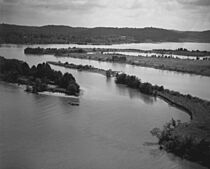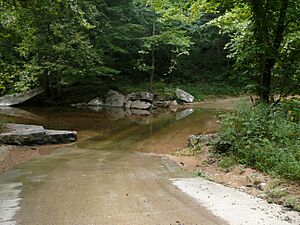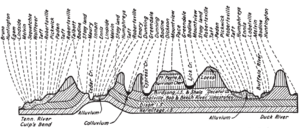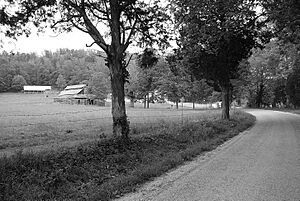Perry County, Tennessee facts for kids
Quick facts for kids
Perry County
|
|
|---|---|
|
County
|
|
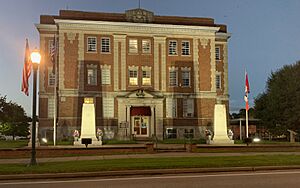
Perry County Courthouse in Linden
|
|

Location within the U.S. state of Tennessee
|
|
 Tennessee's location within the U.S. |
|
| Country | |
| State | |
| Founded | November 14, 1819 |
| Named for | Oliver Hazard Perry |
| Seat | Linden |
| Largest town | Linden |
| Other cities | Lobelville |
| Area | |
| • Total | 423 sq mi (1,100 km2) |
| • Land | 415 sq mi (1,070 km2) |
| • Water | 8.1 sq mi (21 km2) 1.9% |
| Population
(2020)
|
|
| • Total | 8,366 |
| • Density | 20.2/sq mi (7.8/km2) |
| Demonym(s) | Perry Countian |
| Time zone | UTC−6 (Central) |
| • Summer (DST) | UTC−5 (CDT) |
| ZIP Codes |
37097, 37096
|
| Area code | 931 |
| Congressional district | 7th |
| FIPS county code 47135 | |
Perry County is a county found in the state of Tennessee. In 2020, about 8,366 people lived here. It is the least crowded county in Tennessee. The main town and county seat is Linden. The county is named after Oliver Hazard Perry. He was a brave American naval hero from the War of 1812.
The Cherokee people gave this land to the United States in 1806. Perry County was officially created in 1819. It was made from parts of other counties like Wayne, Hickman, and Humphreys. Later, in 1845, the parts of Perry County west of the Tennessee River became Decatur County.
Most of the money in Perry County comes from farming and forests. There are also some small factories and tourism. The county has faced tough economic times. It was hit hard by the Great Recession in 2008. At one point, it had one of the highest unemployment rates in the U.S. Even today, it has lower incomes and more poverty than other parts of Tennessee. Getting around can be tricky because there are no major highways, trains, or big airports.
More than 80 percent of Perry County is covered in trees. Two big rivers, the Buffalo and the Tennessee, shape the land. There are also many hills and valleys. These rivers and fertile lands are great for farming and outdoor fun. Mousetail Landing State Park is a large protected area. It brings many visitors who enjoy nature.
Contents
- Discovering Perry County's Past
- Exploring Geography and Land Features
- Weather and Climate in Perry County
- Animals and Plants of Perry County
- Understanding Perry County's Population
- Perry County's Economy
- Towns and Communities
- Transportation and Public Services
- Education in Perry County
- Media and Fun in Perry County
- Famous People from Perry County
- Images for kids
- See also
Discovering Perry County's Past
Perry County was formed in 1819. It was named after Oliver Hazard Perry. He was a naval officer in the War of 1812. He famously won the Battle of Lake Erie. The first settlements were along Toms Creek. This was near the Tennessee River.
The county seat was first in a town called Harrisburg. This town was about 4 miles (6.4 km) south of where Linden is now. In 1848, the county seat moved to Linden. The old town of Harrisburg no longer exists.
Perry County faced a very hard time during the economic recession of 2008 and 2009. Many people lost their jobs. Unemployment reached almost 29 percent. This was because a large car parts factory closed down. It had employed many people in the county.
Exploring Geography and Land Features
Perry County is located on the western edge of Middle Tennessee. The land here has high ridges. These ridges separate creeks that flow into the county's two main rivers. This is typical of the Western Highland Rim area. The highest point in Perry County is about 980 feet (300 m) above sea level. It is on a ridge in the southeast part of the county.
From 1819 to 1846, the Tennessee River cut the county in half. In 1846, the part west of the river became Decatur County. After a few small changes, the county's borders were set in 1911.
Rivers Flowing Through the County
Three rivers are found in Perry County. They are the Tennessee River, Buffalo River, and Duck River. The Tennessee River forms the western border. The Buffalo River flows through the middle of the county. A small bend of the Duck River briefly enters the county in the far northeast. Even with all this water, there are no large dams in the county.
The Mighty Tennessee River
The Tennessee River creates the western border of Perry County. It separates Perry County from Decatur and Benton counties. The river flows from south to north. Boats can travel its entire length through the county. In 1944, the Kentucky Dam was built. This caused some low-lying areas near the river to flood. Areas next to the river are known as Special Flood Hazard Areas.
Lady's Bluff is about 11 miles (18 km) west of Linden. It is the tallest bluff on the lower Tennessee River. It looks over a narrow part of the river called The Narrows. Here, large barges have to pass one at a time. Lady's Bluff Small Wild Area is a protected park. It includes the bluff and nearby woods.
The Beautiful Buffalo River
The Buffalo River flows from south to north through the county. It then joins the Duck River just north of the county line. More than a quarter of the Buffalo River's watershed is in Perry County. The towns of Linden and Lobelville are along this river. So are the smaller communities of Flat Woods and Beardstown.
Four businesses offer river trips along the Buffalo River. This makes it a popular spot for fun outdoor activities.
Land Shapes and Water Systems
Most of the western part of the county drains into the Tennessee River. The eastern half drains into the Buffalo River. A tiny part of the northeast corner drains into the Duck River. The ground has a lot of water close to the surface. This creates many springs and shallow wells.
Buffalo Ridge runs north to south through the county. It is between the Tennessee and Buffalo rivers. This ridge reaches about 700 feet (210 m) above sea level. Eight smaller ridges extend west from Buffalo Ridge. These create valleys for nine major creeks that flow into the Tennessee River. East of the Buffalo River, other ridges form basins for its tributaries.
Perry County has many natural wetlands. These are areas where the land is wet for much of the year. They are important homes for many types of wildlife.
Soil and Rocks of Perry County
The rivers have left rich soil deposits. These create fertile lands used for farming. The soil is usually very deep. It is good for growing crops and building. The tops of the ridges have well-drained, loamy soil. They also have many chert rock deposits.
Perry County has reserves of chert, sand, gravel, limestone, and phosphate. Cherty limestone is the most common rock. Below it is a layer of siltstone and shale. This layer does not let water pass through easily. This is why there are so many fresh water springs.
Blue and gray limestone can be seen in most valleys. Many fossils have been found in this limestone. Iron ore is also very common. There are many deposits west of Buffalo Ridge.
Neighboring Counties
- Humphreys County (north)
- Hickman County (northeast)
- Lewis County (southeast)
- Wayne County (south)
- Decatur County (west)
- Benton County (northwest)
Weather and Climate in Perry County
Perry County has a humid subtropical climate. This means it has hot, humid summers and cold winters. The average winter temperature is about 47.8°F (8.8°C). The average summer temperature is about 75.7°F (24.3°C). The coldest temperature ever recorded was -1°F (-18°C) in 1963. The hottest was 105°F (41°C) in 1980. The county gets about 5.5 inches (14 cm) of snow each year.
Thunderstorms are common, especially from May to August. Sixteen tornadoes have been reported in Perry County. The first was in 1909. Most have happened since 1999. The deadliest tornado was on May 27, 1917. It killed five people and injured 67. It was rated as an EF/4 tornado. Another strong tornado hit in 1999. It killed three people and damaged Linden. Two more people died in a tornado in 2015.
| EFU | EF0 | EF1 | EF2 | EF3 | EF4 | EF5 | Total |
|---|---|---|---|---|---|---|---|
| 0 | 3 | 6 | 5 | 0 | 2 | 0 | 16 |
| Climate data for Perry County, Tennessee (1991–2020, as recorded in Linden) | |||||||||||||
|---|---|---|---|---|---|---|---|---|---|---|---|---|---|
| Month | Jan | Feb | Mar | Apr | May | Jun | Jul | Aug | Sep | Oct | Nov | Dec | Year |
| Record high °F (°C) | 76 (24) |
82 (28) |
89 (32) |
92 (33) |
96 (36) |
104 (40) |
105 (41) |
105 (41) |
101 (38) |
97 (36) |
93 (34) |
88 (31) |
105 (41) |
| Mean daily maximum °F (°C) | 48.6 (9.2) |
53.2 (11.8) |
62.6 (17.0) |
72.0 (22.2) |
78.7 (25.9) |
85.1 (29.5) |
88.7 (31.5) |
88.5 (31.4) |
83.3 (28.5) |
73.2 (22.9) |
61.4 (16.3) |
51.9 (11.1) |
70.6 (21.4) |
| Daily mean °F (°C) | 37.5 (3.1) |
41.2 (5.1) |
49.3 (9.6) |
58.1 (14.5) |
66.4 (19.1) |
74.0 (23.3) |
77.8 (25.4) |
76.9 (24.9) |
70.5 (21.4) |
59.0 (15.0) |
48.3 (9.1) |
40.7 (4.8) |
58.3 (14.6) |
| Mean daily minimum °F (°C) | 26.5 (−3.1) |
29.2 (−1.6) |
36.1 (2.3) |
44.2 (6.8) |
54.1 (12.3) |
62.9 (17.2) |
67.0 (19.4) |
65.4 (18.6) |
57.8 (14.3) |
44.9 (7.2) |
35.2 (1.8) |
29.6 (−1.3) |
46.1 (7.8) |
| Record low °F (°C) | −18 (−28) |
−10 (−23) |
6 (−14) |
19 (−7) |
30 (−1) |
36 (2) |
46 (8) |
41 (5) |
35 (2) |
21 (−6) |
6 (−14) |
−8 (−22) |
−18 (−28) |
| Average precipitation inches (mm) | 4.60 (117) |
4.91 (125) |
4.93 (125) |
5.64 (143) |
6.36 (162) |
5.31 (135) |
5.06 (129) |
3.20 (81) |
4.20 (107) |
3.82 (97) |
3.89 (99) |
5.67 (144) |
57.59 (1,463) |
| Average snowfall inches (cm) | 0.9 (2.3) |
0.7 (1.8) |
0.4 (1.0) |
0.0 (0.0) |
0.0 (0.0) |
0.0 (0.0) |
0.0 (0.0) |
0.0 (0.0) |
0.0 (0.0) |
0.0 (0.0) |
0.0 (0.0) |
0.1 (0.25) |
2.1 (5.3) |
| Average precipitation days (≥ 0.01 in) | 9.0 | 8.5 | 9.0 | 8.7 | 9.4 | 8.2 | 8.2 | 6.8 | 6.5 | 7.1 | 7.9 | 9.1 | 98.4 |
| Average snowy days (≥ 0.1 in) | 0.3 | 0.4 | 0.2 | 0.0 | 0.0 | 0.0 | 0.0 | 0.0 | 0.0 | 0.0 | 0.0 | 0.0 | 0.9 |
| Source: NOAA | |||||||||||||
Animals and Plants of Perry County
About 80% of Perry County is covered in forests. Many important trees grow here. These include white oak, walnut, and hickory. Over 561 types of wild plants have been found in the county.
Perry County has many native game animals. These include whitetail deer, rabbit, and eastern wild turkey. You can also find gray squirrels and fox squirrels. Bobwhite quail are present, but their numbers are low. Mourning doves also pass through during their seasonal migrations.
Common water birds include wood ducks and mallards. The Buffalo River is a special place for wood ducks to nest. Mink, muskrat, and beaver live in the wetlands. There are also many bobcats, opossums, and coyotes. The county is home to many reptiles, amphibians, and birds.
Alexander Cave is in the northeast part of the county. It is an important place for the endangered gray bat to rest and hibernate. Many types of fish live in the rivers and streams. These include largemouth bass, smallmouth bass, and catfish. The rich wildlife has always been a big reason for tourism in the county.
Long ago, very large animals lived here. In 1820, the bones of a huge animal were found in a cave. It might have been a giant ground sloth. These bones were later lost.
Bringing Back Wildlife
By the late 1940s, there were very few whitetail deer left in Tennessee. They had been hunted almost to extinction. In the 1930s, groups like the Tennessee Game and Fish Commission started bringing deer back. In 1949, they began reintroducing deer in Perry County. By the 1950s, the deer population had grown enough for limited hunting. In 1960, 30 deer were hunted. By 1996, that number was almost 2,200.
Wild turkeys had also disappeared from the county by the 1950s. The Tennessee Wildlife Resources Agency worked to bring them back. This program was successful. Now, turkeys have returned to the county.
Understanding Perry County's Population
Perry County is a rural area with few people. Its population is 8,366. This makes it the least crowded county in Tennessee. The population was highest in 1910, with 8,815 people. It then slowly went down until 1970. After 1970, the population started growing again. But it still has not reached the numbers of the early 1900s. The county is less diverse than the rest of Tennessee. About 93% of the people are white.
| Historical population | |||
|---|---|---|---|
| Census | Pop. | %± | |
| 1820 | 2,384 | — | |
| 1830 | 7,094 | 197.6% | |
| 1840 | 7,419 | 4.6% | |
| 1850 | 5,821 | −21.5% | |
| 1860 | 6,042 | 3.8% | |
| 1870 | 6,925 | 14.6% | |
| 1880 | 7,174 | 3.6% | |
| 1890 | 7,785 | 8.5% | |
| 1900 | 8,800 | 13.0% | |
| 1910 | 8,815 | 0.2% | |
| 1920 | 7,765 | −11.9% | |
| 1930 | 7,147 | −8.0% | |
| 1940 | 7,535 | 5.4% | |
| 1950 | 6,462 | −14.2% | |
| 1960 | 5,273 | −18.4% | |
| 1970 | 5,238 | −0.7% | |
| 1980 | 6,111 | 16.7% | |
| 1990 | 6,612 | 8.2% | |
| 2000 | 7,631 | 15.4% | |
| 2010 | 7,915 | 3.7% | |
| 2020 | 8,366 | 5.7% | |
| U.S. Decennial Census 1790–1960 1900–1990 1990–2000 2010–2014 |
|||
2020 Census Details
| Race | Number | Percentage |
|---|---|---|
| White (non-Hispanic) | 7,700 | 92.04% |
| Black or African American (non-Hispanic) | 195 | 2.33% |
| Native American | 41 | 0.49% |
| Asian | 26 | 0.31% |
| Pacific Islander | 1 | 0.01% |
| Other/Mixed | 276 | 3.3% |
| Hispanic or Latino | 127 | 1.52% |
In 2020, there were 8,366 people living in Perry County. There were 3,073 households and 2,068 families.
Perry County's Economy
Farming is a big part of Perry County's economy. In 2017, there were 287 farms. Each farm was about 215 acres (87 hectares) on average. Over 35,000 acres (14,000 hectares) of land were used for crops, forests, and pastures. In 2018, farming and related businesses added $49.6 million to the county's economy. They also provided 525 jobs. This was about 17% of all jobs in the county.
Mousetail Landing State Park is the largest protected area. It brings many nature tourists to the region. In 2021, tourists spent $5.8 million in the county. This money created about 54 jobs. These jobs paid about $900,000 in wages. Another protected area is Lady's Bluff Small Wild Area. It is popular for nature walks and rock climbing.
The Perry County Chamber of Commerce works to attract more nature tourists. Their slogan is "Perry County: It's Just Our Nature." In 2008, the first annual Blooming Arts Festival was held in Linden. This was another way to boost tourism. There is only one hotel in Perry County, the Commodore Hotel in Linden.
The first bank in Perry County was the Linden Bank and Trust. It started around 1890. Now, it is a branch of FirstBank. The other bank, the Bank of Perry County, began in 1905. It was first called the Bank of Lobelville.
Economic Challenges and Recovery
Perry County faces many economic challenges. It is one of the poorest counties in Tennessee. It ranks among the bottom 10% of U.S. counties for poverty, unemployment, and income. The county has higher income inequality than the rest of Tennessee. In 2020, the total value of goods and services produced in the county was $190 million. In 2019, about 16.1% of people lived in poverty. This is higher than the state average.
The average household income was $41,034. The income per person was $27,970. Property values are much lower than the state average. In 2019, the average value of a home was $88,100. This is compared to $167,200 statewide. However, more people own their homes in Perry County (82%) than in the rest of Tennessee (66%).
It is hard for the economy to grow here. There is not enough reliable internet access. There are no major highways or nearby meat processing plants.
Perry County was hit very hard by the economic recession of 2008 and 2009. Unemployment reached almost 29%. This was the highest in Tennessee and second highest in the U.S. A large car parts factory closed. This caused many people to lose their jobs. The governor at the time, Phil Bredesen, focused on helping Perry County. Within two years, unemployment dropped to 14%. In 2012, a new car parts company opened. It created over 400 jobs. This greatly helped reduce unemployment.
In April 2020, unemployment rose again to over 24%. This was due to the COVID-19 pandemic. A rubber parts factory, the largest employer in Lobelville, also closed. By May 2024, unemployment had fallen to 3.6%. While much lower, it was still higher than the state average.
Towns and Communities
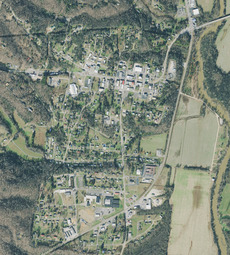
Linden is the county seat. It is in the middle of the county. It is where U.S. Route 412 and Tennessee State Route 13 meet. Lobelville is another town. It is located along State Route 13 in the northern part of the county. Besides these two towns, there are many smaller communities throughout the county.
Towns by Population
| Place | Population | Founded |
|---|---|---|
| Linden | 997 | 1848 |
| Lobelville | 919 | 1854 |
Smaller Communities
- Beardstown
- Chestnut Grove
- Flat Woods
- Horner
- Pine View
- Peters Landing
- Pope
- Spring Creek
- Standing Rock
- Sugar Hill
Transportation and Public Services
Perry County has one U.S. highway. It also has several state highways. There is one small airport. However, there are no railroads or major Interstate Highways. The Alvin C. York Bridge carries U.S. Route 412 over the Tennessee River. It is the only bridge crossing the river in the county. Even though the western border is a major river for boats, there are no large ports.
There are no public transportation systems. Also, no commercial passenger flights operate here. A 2015 study showed that people in Perry County drive alone to work more than in any other Tennessee county. This shows that carpooling or public transport are not common.
Poor transportation has always been a problem. In 1874, a report noted that a lack of trains, paved roads, and bridges made it hard for the economy to grow. In 1906, newspapers again said that no railroad access limited economic growth.
Main Roads in Perry County
One federal highway and several state highways cross the county. U.S. Route 412 connects Linden to Parsons (18 miles west) and Hohenwald (19 miles east). Tennessee State Route 20 runs with U.S. Route 412. Tennessee State Route 100 also runs with U.S. Route 412 for much of its way. The main north-south road is Tennessee State Route 13. It connects to Interstate 40 north of Lobelville.
U.S. Route 412 west of Linden and State Route 13 south of Linden are called Tennessee Parkways. State Route 13 and State Route 128 are part of the Tennessee River Trail Scenic Byway.
 US 412
US 412 SR 13
SR 13 SR 20
SR 20 SR 48
SR 48 SR 100
SR 100 SR 128
SR 128 SR 438
SR 438
Airports in the County
Perry County has a small public general aviation airport. It is called James Tucker Airport. It was built in 1962 south of Linden. Efforts to build an airport started in 1946. Students from Lobelville High School asked the county to build one. There is also a private helipad at the former Perry Community Hospital in Linden.
Pipelines and Utilities
A natural gas pipeline crosses Perry County. It is operated by Tennessee Gas Pipeline. There is a pumping station for the pipeline in Lobelville. This station and nearby parts of the pipeline are an EPA Superfund site. This means the area needs to be cleaned up due to pollution.
In 1900, Bell Telephone Company started phone service in the county. As of 2020, about 59% of homes have broadband internet. This is lower than the state average of 78%.
Electric power is provided by Meriwether Lewis Electric Cooperative. This company gets power from the Tennessee Valley Authority. Many parts of the county did not have electricity until the mid-1900s. Some areas, like Flatwoods, did not get power until 1950.
Education in Perry County
Perry County has one school district. It is called the Perry County School System. There are four schools:
- Perry County High School
- Linden Middle School
- Linden Elementary School
- Lobelville School
The county also has the Perry County Virtual School. This is a public online learning system for students in grades 4 through 12.
The first high school in the county opened in Linden in 1922. Before that, students had to leave the county for high school. The current Perry County High School opened in 1963. It combined the high schools from Linden and Lobelville. Some parents in Lobelville did not want the schools to combine. They worried about the distance and if the new school would be ready.
In 1963, the state allowed Lobelville to have its own school district. But the Tennessee Board of Education said it would not give money to this new district. They also would not approve it. A group of parents sued to keep the school open. Volunteer teachers taught for the 1963 school year. In 1964, the Tennessee Supreme Court said the state board was right to deny funding. The Lobelville school closed later that year.
Before the 1964 Civil Rights Act, black children in the county could not attend high school there. In 1954, the county hired McDonald Craig. He was a local black farmer and Korean War veteran. He drove a bus to take black children to high school outside the county. He bought a school bus from a local car dealer. This dealer was related to the owners of Craig's enslaved grandparents. Craig drove black students to Montgomery High School in Lexington, Tennessee. This bus program lasted until 1965. That is when the county's schools became integrated.
The high school graduation rate in Perry County is very high, at 97.5%. The state average is 90.4%. About 75% of adults over 25 have a high school diploma. About 12% have a college degree or higher. These numbers are lower than the state averages.
In 1947, the county started a public library. By 1986, there were two public libraries. One was in Linden and one in Lobelville.
Media and Fun in Perry County
Perry County has had many radio stations and newspapers over the years. As of 2022, there are two radio stations: WOPC (FM) and WMAK (AM). Six different newspapers have been printed in the county. The first was the Linden Times in 1880. The Buffalo River Review started in 1976. It joined with the Perry Countian in 1978. It is still published weekly as the county's only print newspaper.
Music and Movies
In 1928, the Weems String Band recorded music. They were a folk music group from Perry County. Their recordings are considered some of the best folk music of that time. The famous cartoonist Robert Crumb even drew the band for a series of trading cards.
In 1957, a movie called Natchez Trace was filmed in the southern part of the county. Many local people appeared in the movie as extras. It was about a bandit named John Murrell.
Perry County was featured on the TV show Unsolved Mysteries in 1992. The episode was about George Owens. He was an elderly man who disappeared in 1985. He was last seen in Lobelville. His car was found six days later in a remote part of the county. He was declared legally deceased in 1993.
Sports and Athletics
Perry County does not have any professional sports teams now. But in the past, it had two semi-professional baseball teams. From the 1920s to the late 1940s, both Lobelville and Linden had teams. Baseball was a very popular pastime. Rivalry games on holidays would even have famous musicians. Bill Monroe, known as the father of bluegrass music, once played at a game. Linden's team, the Owls, won at least three state baseball championships.
Perry County high school sports teams have done well in state competitions. Especially in basketball. In 1955, Linden High School's boys' basketball team won the state championship. They won it three years in a row. After Linden High School combined with Lobelville High School, Perry County High School won boys' basketball state championships again in 1976, 1977, and 1997.
Famous People from Perry County
- William Morgan Conder – a politician
- McDonald Craig – a musician
- John Allen Greer – a politician
- Kelsie B. Harder – a professor and name scholar
- Bob Harris – a professional basketball player
- Kirk Haston – a politician and former professional basketball player
- Clyde Milan – a professional baseball player and coach
- Obediah Pickard – a musician
- Thetus W. Sims – a politician, who was a member of the U.S. House of Representatives
- Helen Craig Smith – an author and educator
Images for kids
-
Perry County Courthouse in Linden
See also
 In Spanish: Condado de Perry (Tennessee) para niños
In Spanish: Condado de Perry (Tennessee) para niños


